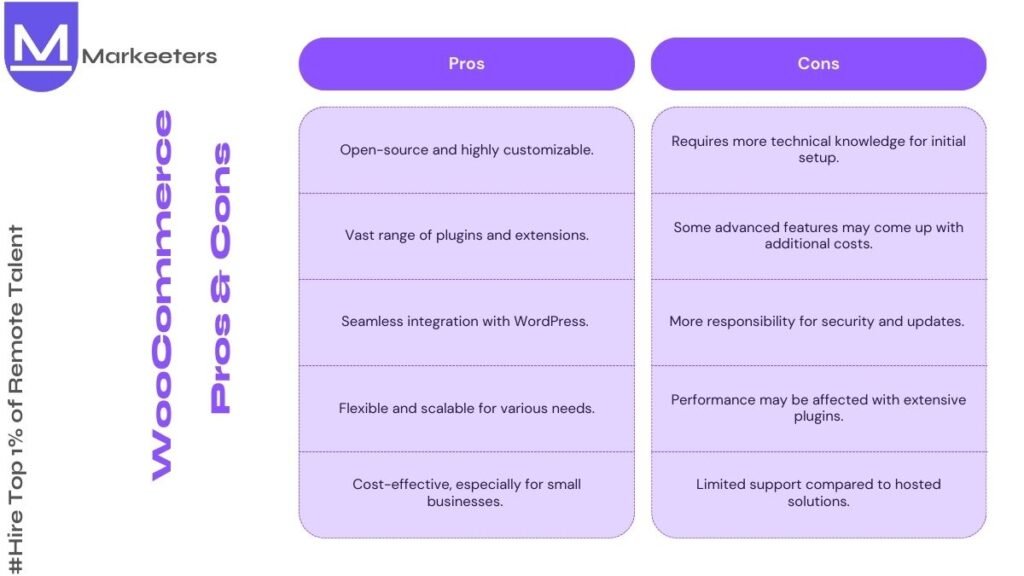Navigate the e-commerce world: WooCommerce vs Shopify. Discover the superior platform in this detailed guide. Choose wisely, thrive online!
Introduction
By 2026, it is estimated that the value of e-commerce retail sales will reach 9.4 trillion U.S. dollars on a global scale. In recent years, the e-commerce sector has experienced rapid expansion, with new trends and technology appearing seemingly every day. The revenue potential and appeal of dropshipping as an e-commerce company strategy are two things that never change. WooCommerce and Shopify are the two most common choices when it comes to e-commerce for your dropshipping business. In this blog, you will learn about:
- What is WooCommerce? (Pros and Cons)
- What is Shopify? (Pros and Cons)
- WooCommerce vs Shopify: A Detailed Comparison
Let’s get started!
What is WooCommerce? (Pros and Cons)
WooCommerce is a popular content management system (CMS). It is also the most widely used plugin for WordPress. You can simply combine its extensive collection of over 2,000 free and premium themes into the platform. This helps personalize the look and feel of your online business. WooCommerce also offers under 1,000 plugins that you can add to your site to increase its performance.
These plugins provide a range of features and advantages to fulfill your particular goals. An amazing feature is that it can be downloaded, hosted, and used for free because it is an open-source platform. This makes it an affordable option for setting up and running your online business.

What is Shopify? (Pros and Cons)
Shopify is considered to be the most effective e-commerce system on the market. It is renowned for being the simplest method to sell products online. Through its marketplace and third-party websites, users can purchase and download a wide range of 1400+ themes, both free and premium. These themes are made to offer aesthetically pleasing and clean stores that effectively display your products.
It is important to remember that even though Shopify is free to use, they still charge a monthly hosting fee. Shopify provides security and maintenance services, all of which are covered by this charge, guaranteeing a dependable and safe online selling environment.

WooCommerce vs Shopify: A Detailed Comparison
The purpose of this comparison between WooCommerce vs Shopify is to help you in determining which platform could be most suitable for your needs. Let us take you through this comparative journey.
1. WooCommerce vs Shopify: Themes and Designs
94% of first impressions are in fact related to design. This implies that a large number of potential consumers who are new to your online presence will evaluate your business based on its appearance. This signifies that design is essential to the success of your e-commerce business. So, make sure that you do it right.
| WooCommerce | Shopify |
|---|---|
| WooCommerce offers a variety of themes and design choices. It provides both free and premium options. The platform has a dedicated theme store. The quality of themes varies greatly. You will probably need some design or coding experience to make the most of its design options. It also requires technical know-how to change the look and feel of your business. | Shopify offers a dedicated theme shop with a selection of both free and premium themes. The drag-and-drop interface will allow you to easily change the look and feel of themes. It is meant to be user-friendly and flexible. Shopify has a substantial marketplace for third-party themes in addition to its own theme shop, giving users even more options. |
Verdict: WooCommerce has almost infinite customization options, which is why it is suitable for businesses of any size. It beats Shopify.
2. WooCommerce vs Shopify: SEO
| WooCommerce | Shopify |
|---|---|
| WordPress is popular for having excellent SEO capabilities; therefore, WooCommerce gives users more control over SEO-related factors, such as metadata, meta descriptions, URLs, and site structure. WooCommerce is also open-source. This helps users modify the code to improve the SEO of their business. One way to improve search engine results is by optimizing your code for faster load times. Yoast SEO and All in One SEO Pack are only two of the well-known SEO plugins that WooCommerce benefits from. | Shopify has a variety of SEO-friendly features, including customizable titles and meta descriptions, relevant tags, and automated sitemap building. In recent years, the platform has made some fair changes to its SEO tools. It includes its own metrics analysis tools in addition to being able to be combined with Google Analytics. |
Verdict: Because there are many marketing and SEO tools accessible as WordPress plugins, WooCommerce surpasses Shopify.
Read more: Is Pinterest Social Media or a Search Engine?
15 Powerful Reasons Your Business Requires SEO Today
3. WooCommerce vs Shopify: Ease of Use
| WooCommerce | Shopify |
|---|---|
| WooCommerce is a self-hosted platform. This implies that you will be in charge of handling software upgrades, security, and hosting. WooCommerce offers tools and documentation to assist you with setting up your online store; however, it is more difficult to use and consumes a lot of time. | Shopify is easy to operate. Non-technical users and small businesses will find it easy to use. Shopify is a hosted platform, which means you don’t have to worry about any of the technical elements of managing an online business. You don’t have to worry about server maintenance, security, software upgrades, or backups. Shopify takes care of all these things. |
Verdict: Shopify beats WooCommerce as it is simple to use. It is far more user-friendly. You don’t need to have a lot of technical expertise to use this platform as compared to WooCommerce, which is more technical to use.
4. WooCommerce vs Shopify: Payment Options
| WooCommerce | Shopify |
|---|---|
| Multiple payment gateways are available for WooCommerce. They can be added using plugins or extensions. PayPal, Stripe, Authorize.net, and Amazon Pay are a few of the common choices. Payments made through third-party gateways are not subject to transaction fees from WooCommerce; however, the payment processor or gateway might impose certain costs. | Shopify provides a range of payment methods, including digital wallets like Apple Pay and Google Pay, debit cards, and credit cards. Although users have the option to add third-party gateways, Shopify Payments is the standard payment gateway for all shops. In addition to any costs levied by the payment processor or gateway, Shopify charges transaction fees for payments made via third-party gateways. |
Verdict: WooCommerce is a more suitable option for sellers who are ready to handle their own merchant accounts and would like greater control over how their payments are processed. For massive production sellers looking to negotiate cheaper processing rates and steer clear of platform transaction costs, this can be helpful.
5. WooCommerce vs Shopify: Costs
| WooCommerce | Shopify |
|---|---|
| With WooCommerce, your only monthly expenses are domain registration and hosting, which can range from a few dollars to several hundred dollars, depending on the hosting company and the degree of support needed. A wide variety of premium and free extensions, including payment gateways, shipping choices, and marketing tools, are also available for WooCommerce, and they can improve the platform’s features. | Shopify provides a wide range of price options based on requirements. A variety of fundamental features, including hosting and domain registration, are all included in that $29 monthly basic package. In addition to extra services like sophisticated reporting and third-party estimated shipping prices, the advanced plan can cost up to $29 per month. You can further personalize Shopify with a variety of premium apps and themes that are available on the platform. |
Verdict: WooCommerce can be a more affordable choice if you need a easy-to-use e-commerce website with essential features.
6. WooCommerce vs Shopify: Platform Model
| WooCommerce | Shopify |
|---|---|
| WooCommerce is an open-source platform. This signifies that anybody can download, change, and share the source code without restriction. A sizeable developer and user community contributes to its advancement. This means that new features and plugins are constantly introduced. Also, issues are quickly fixed as soon as they are found. | Shopify is a closed-source platform. It has its own benefits. It is a dependable and safe platform. It is in charge of managing the platform and handling all upgrades and servicing. This signifies that maintaining your hosting environment and making sure your software is updated are not concerns for you. Additionally, Shopify maintains a thorough app review procedure to guarantee the security and dependability of every app on the store. |
Verdict: Here, Shopify outshines WooCommerce because you do not have to worry about updating your hosting environment from time to time. You can concentrate on your work, and it won’t hamper your productivity.
7. WooCommerce vs Shopify: Blogging
| WooCommerce | Shopify |
|---|---|
| The blogging feature of WooCommerce, which is based on WordPress, is extensive and includes a user-friendly blogging interface, backing up categories and tags, and the option to plan out articles in advance. Additionally, it gives you a great degree of freedom and control by enabling you to modify the look and feel of your blog using WordPress themes and plugins. | Shopify has fewer blogging features. Basic functions like creating and publishing posts, classifying articles, and adding tags are included in the blogging system. The blogging interface lacks some of the customization features. It is less user-friendly and adaptable. |
Verdict: WooCommerce has better features than Shopify, which gives it an advantage if you want to make blogging a major part of your content marketing strategy for your online store.
8. WooCommerce vs Shopify: Store Performance
| WooCommerce | Shopify |
|---|---|
| The function of WooCommerce-powered will depend on hosting quality. The platform itself is designed for WordPress; however, WooCommerce can perform on a range of hosting systems. | Shopify’s internal infrastructure is in charge of overseeing the performance of its own stores. It used a content delivery network (CDN) in order to improve website speed and performance. Additionally, Shopify provides a number of built-in performance-enhancing tools, such as image optimization and caching. |
Verdict: Shopify has a little advantage here. It is a fully hosted platform and has integrated performance features. However, WooCommerce may potentially give outstanding performance with the right hosting and optimization.
9. WooCommerce vs Shopify: Inventory
| WooCommerce | Shopify |
|---|---|
| You can control your inventory with WooCommerce by defining stock levels for each product. Notifications of low stock levels can be sent, and inventory can be checked. It does not have an integrated inventory management systems; therefore, you will have to manage your inventory using a third-party plugin or program. This should not be an issue because there are several third-party inventory management plugins for WooCommerce. You can handle orders, check stock levels, and coordinate inventory across several sales channels with the aid of these plugins. | The inventory management system that is integrated with Shopify makes it simple to track and manage stock levels. Every product has its own set of stock levels, and you can create alerts for low stock. Additionally, you can monitor inventories through a variety of sales channels, including social media, marketplaces, and your online store. Shopify’s app store offers a number of inventory management applications as well. |
Verdict: Shopify has more advantages here. It has an in-built inventory management system, which makes it easier for businesses to maintain everything in one place.
WooCommerce vs Shopify: Conclusion
WooCommerce is the most popular plugin/module on the entire internet – with 68% usage distribution. WooCommerce is perfect for companies that need sophisticated modifications and have a high degree of technical competence since it offers more control and customization choices. Additionally, WooCommerce provides a wide variety of payment gateways, helping companies take payments from clients all around the world. Businesses that operate internationally will find this feature very helpful.
Shopify is sued over 175 countries globally. Shopify provides a more simplified and user-friendly solution. It is suitable for businesses that value simplicity and speedy set-ups without a lot of technical work. Shopify is the obvious choice for companies that don’t know much about technology. Shopify is an excellent choice for people who wish to start their business quickly because of its simple setup and easy-to-use interface.
More resources for you:
Squarespace vs BigCommerce: Which is Best for Your Online Store?
AI Tools That Existed Before OpenAI’s GPT You Didn’t Know About
10 Cool Canva Hacks for Creative Small Business Owners
FAQs
Which is cheaper, Shopify or WooCommerce?
When it comes to price, WooCommerce is thought to be more affordable than Shopify. This is because you don’t pay any monthly membership fees because it is open-source and free to use.
Is it better to use WooCommerce or Shopify?
Shopify and WooCommerce are both excellent choices for managing a dropshipping company. WooCommerce has a little advantage because of its great degree of customization, numerous plugins, and ease of use.
What should you look for an e-commerce platform?
A good platform should have strong security features, be simple to set up and use, and be scalable to support expansion. Along with a variety of shipping choices and payment gateways, it should integrate with other tools like analytics, social media, and email marketing. Outstanding customer service, which includes a knowledge base, documentation, and prompt assistance, is another essential component. ZZ





